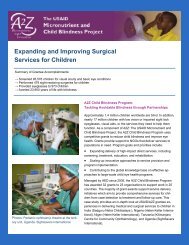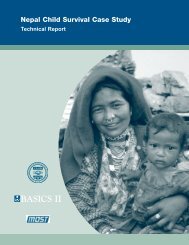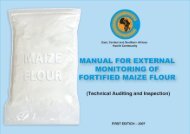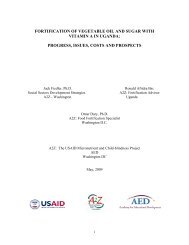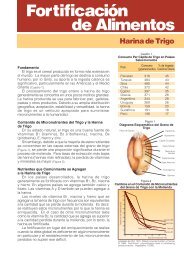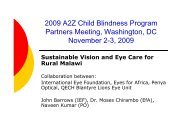Seeing the World through New Lenses: Providing ... - Seva Foundation
Seeing the World through New Lenses: Providing ... - Seva Foundation
Seeing the World through New Lenses: Providing ... - Seva Foundation
You also want an ePaper? Increase the reach of your titles
YUMPU automatically turns print PDFs into web optimized ePapers that Google loves.
4<br />
who have undergone cataract surgery without an intraocular<br />
lens to replace <strong>the</strong> lens that was removed). For <strong>Seva</strong>/<br />
Nepal, regular lenses can be ground by primary eye care<br />
centers. Aphakic glasses, however, are not often in stock,<br />
and <strong>the</strong> thick lenses are difficult to fit into small frames.<br />
Higher power lenses must be obtained from tertiary hospitals,<br />
which can be located far from where children live.<br />
Barriers to Acceptance<br />
Projects also faced barriers to <strong>the</strong> acceptance of eyeglasses<br />
among children. According to Fred Hollows <strong>Foundation</strong><br />
in Vietnam, children do not like to wear glasses—<br />
particularly <strong>the</strong> thick-framed glasses that are commonly<br />
distributed—because <strong>the</strong>y are ridiculed by <strong>the</strong>ir peers.<br />
Projects work to overcome this challenge by offering a<br />
wide variety of glasses and allowing children to choose<br />
<strong>the</strong>ir own frames. Projects also teach children how to care<br />
for lenses and when to seek help to replace <strong>the</strong>m, giving<br />
<strong>the</strong>m a sense of ownership over <strong>the</strong>ir glasses.<br />
Ophthalmologists working with Fred Hollows <strong>Foundation</strong><br />
conduct refraction in Vietnam.<br />
Training and Selection of Vision Screeners<br />
Experience from <strong>Seva</strong>/Cambodia and <strong>Seva</strong>/Nepal suggests<br />
that screening efficacy varies with a screener’s attitude<br />
and motivation. Dr. A.S. Karthikeyan, a <strong>Seva</strong> trained<br />
pediatric ophthalmologist working in Nepal, said: “Different<br />
levels of motivation among people can affect <strong>the</strong> results. A<br />
well motivated teacher can do a very good job at screenings,<br />
thus ensuring that children receive quality screenings<br />
and refraction services. Fred Hollows in Vietnam<br />
works with reputable glasses suppliers and professional<br />
refractionists or ophthalmologists to ensure <strong>the</strong> accuracy<br />
of lens prescription and quality of frames. In Cambodia,<br />
<strong>Seva</strong> ensures that only refractionists or refraction nurses<br />
from clinics and hospitals write prescriptions for children<br />
with refractive errors.<br />
Barriers to Access<br />
Grantees found that parents who have to travel long distances<br />
with children to reach an eye clinic, or those who<br />
have difficulty locating <strong>the</strong> glasses dispensary inside a<br />
hospital often defer <strong>the</strong> purchase of glasses for children,<br />
or don’t buy <strong>the</strong>m at all. <strong>Seva</strong>/Nepal found that placing <strong>the</strong><br />
glasses dispensary inside <strong>the</strong> pediatric unit where children<br />
receive services often ensures that parents take <strong>the</strong>ir children<br />
to get <strong>the</strong> glasses <strong>the</strong>y need in a more timely manner.<br />
<strong>Seva</strong>/Nepal, <strong>Seva</strong>/Cambodia, and Fred Hollows <strong>Foundation</strong><br />
make services and glasses more accessible to children<br />
by dispensing glasses at schools and o<strong>the</strong>r screening<br />
sites whenever possible, and providing glasses at no<br />
cost to children whose families can not afford <strong>the</strong>m. Using<br />
community-based approaches, all projects work to bring<br />
eye care services closer to poor, rural villages, thus removing<br />
transportation and o<strong>the</strong>r logistical barriers to access.<br />
Although programs did not experience difficulty in obtaining<br />
eyeglasses for lower refractive errors, Himalayan<br />
Cataract Project, <strong>Seva</strong>/Nepal, and <strong>Seva</strong>/Cambodia reported<br />
challenges in getting bifocals, glasses for higher<br />
refractive errors, and glasses for aphakic children (those<br />
1<br />
In Cambodia, <strong>Seva</strong> found that many people believe<br />
glasses actually exacerbate refractive error, and that children<br />
are often afraid that <strong>the</strong>ir parents won’t let <strong>the</strong>m play<br />
computer games or read comic books if <strong>the</strong>y find out <strong>the</strong>y<br />
are having vision trouble. The projects worked to combat<br />
<strong>the</strong>se and o<strong>the</strong>r misconceptions <strong>through</strong> school and community-based<br />
advocacy and education, teaching parents<br />
and children about <strong>the</strong> importance of correcting vision<br />
problems, and indicating that glasses will actually help<br />
children participate in <strong>the</strong> activities <strong>the</strong>y enjoy.<br />
Follow-up<br />
Projects provide quality follow-up care to ensure that children<br />
are wearing glasses and have <strong>the</strong> correct prescription.<br />
Himalayan Cataract Project provides follow-up services<br />
to children with refractive error 6-8 months after <strong>the</strong>ir<br />
initial visit, while children with refractive error and amblyopia<br />
receive follow-up 2 and 4 months later. Teachers<br />
working with Fred Hollows <strong>Foundation</strong> in Vietnam ensure<br />
children are wearing <strong>the</strong>ir glasses in school, and remind<br />
children of <strong>the</strong> importance of periodic follow-up eye exams.<br />
Results<br />
From April 2008—March 2010, <strong>the</strong> projects screened<br />
950,000 children for visual acuity and basic eye conditions,<br />
identified 14,000 children with visual impairment,<br />
and provided eyeglasses to 20,000 children in need. For<br />
every 100 children screened, one child received glasses.<br />
Each of <strong>the</strong>se child eye care programs overcame barriers<br />
to successfully provide quality services, educate <strong>the</strong> public,<br />
and create local partnerships and referral networks.<br />
Lessons Learned and Way Forward<br />
4 · Refractive Error Services for Children



